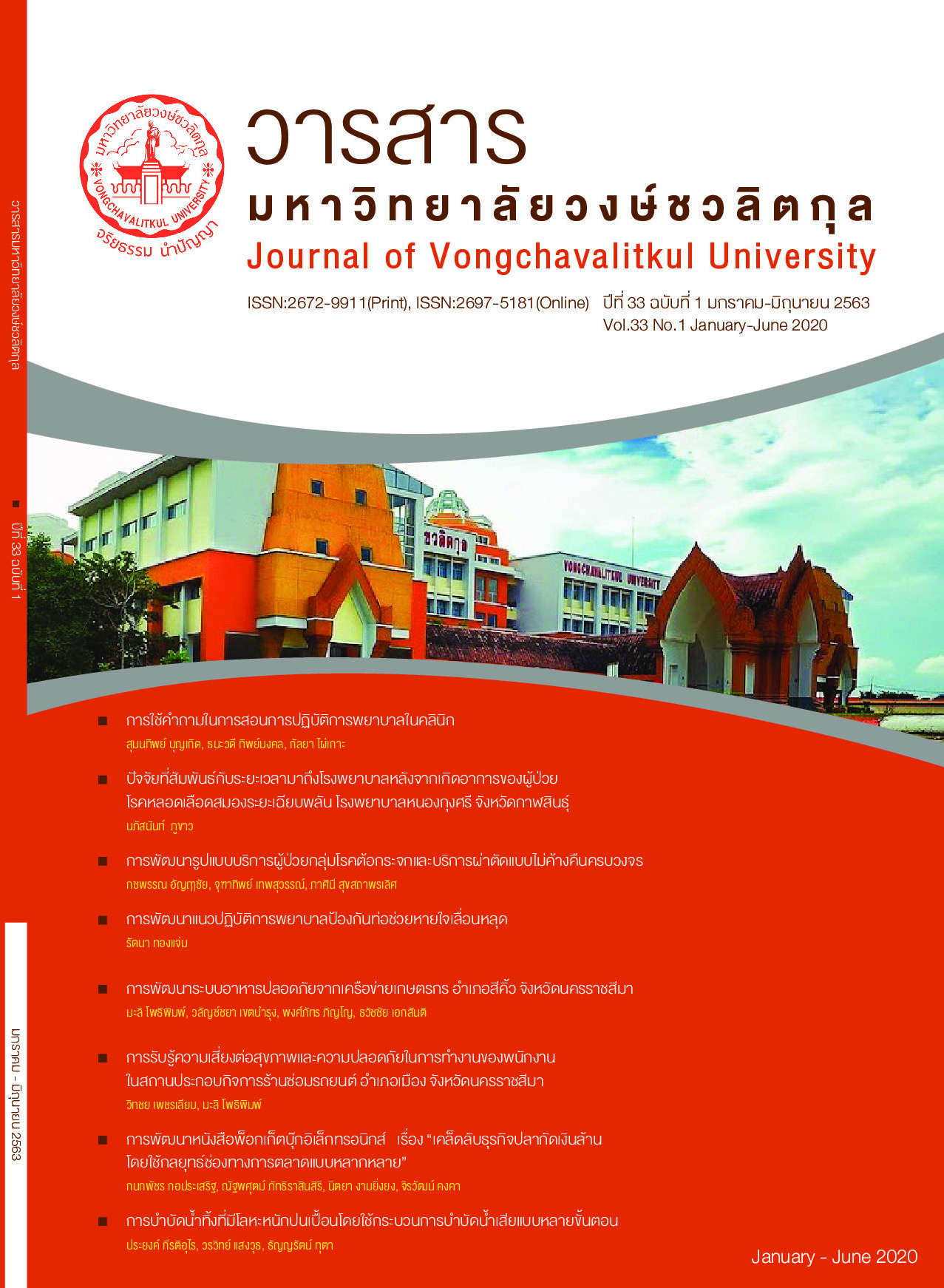Factors Related to Onset to Arrival Time in Acute Ischemic Stroke Patients Admitted into Nongkungsi Hospital, Karasin Province
Keywords:
acute ischemic stroke, prehospital timeAbstract
Objectives: This Retrospective research aimed to study the prehospital time of patients after acute ischemic stroke symptoms and factors related to the prehospital time in patients after acute ischemic stroke symptoms in Nongkungsi Hospital.
Methods: One hundred and two patients with acute ischemic stroke admitted in Nongkungsi Hospital were recruited. The instruments used for data collection were the demographic data form, knowledge about stroke, and the prehospital time of patients with acute ischemic stroke. Data were analyzed by using descriptive statistics and chi-square.
Results: The study revealed that most of the patients were male (52.0%), average age at 64 years (S.D. = 11.62), education level below Primary School (56.9 %), had no-occupation (53.9%), traveled to hospital after acute ischemic stroke symptoms by personal and public car, not by Emergency Medical Service (82.3%), the average prehospital time after acute ischemic stroke symptoms was 22.4 hr., and prehospital time was longer than 270 minutes (51.96%). The study found that the knowledge and information about stroke had statistically significant relationship with prehospital time of patients after acute ischemic stroke symptoms at p <0.05. The results of this research suggests that the knowledge and information of stroke symptoms and symptom management should be provided to those people close to the patients who are at risk for stroke. So that the patients can get early access and receive proper treatments.
References
2. จิณัฐตา คำสารีรักษ์. (2558). ปัจจัยคัดสรรที่สัมพันธ์กับระยะเวลาการมารับการรักษาของผู้ป่วยโรคหลอดเลือดสมองขาดเลือดระยะเฉียบพลัน. วารสารพยาบาลตำรวจ. 7(2), 106-19.
3. ณัฐธิวรรณ พันธ์มุง และคณะ.ประเด็นสารรณรงค์วันอัมพาตโลก [Internet]. [cited 2019June 6]. Availablefrom:https://ddc.moph.go.th/uploads/files/78a5b91d92a079c1a35867c6347a9299.pdf
4. ตวงทิพย์ บินไทยสงค์. ปัจจัยที่สัมพันธ์กับระยะเวลามาถึงโรงพยาบาลหลังจากเกิดอาการของ ผู้ป่วยโรคหลอดเลือดสมองระยะเฉียบพลัน [Internet]. [cited 2019 June 6]. Available from:https://dric.nrct.go.th/Search/SearchDetail/281980
5. นิสสา อาชวชาล. (2562). การศึกษาความสัมพันธ์ของการประเมินผลเอกซเรย์-คอมพิวเตอร์โดยใช้ Alberta Stroke Program EarlyCT Score กับการพยากรณ์ความสามารถในการทำงานของร่างกายผู้ป่วยโรคเลือดสมองชนิดขาดเลือดเฉียบพลันภายหลังการรักษาด้วยยาละลายลิ่มเลือดทางหลอดเลือดดำ โรงพยาบาลโพนทอง จังหวัดร้อยเอ็ด. วารสารวิชาการสาธารณสุข, 28(2), 297-312.
6. พัสตราภรณ์ ปัญญาประชุม. (2559). ปัจจัยที่มีความสัมพันธ์กับการมารับการรักษาในโรงพยาบาลที่ใช้ระบบเครือข่ายการส่งต่อช่องทางด่วนของผู้ป่วยโรคหลอดเลือดสมองระยะเฉียบพลัน. (วิทยานิพนธ์ปริญญามหาบัณฑิต). มหาวิทยาลัยธรรมศาสตร์. กรุงเพทฯ.
7. พรรณวลัย ผดุงวณิชย์กุล. โรคหลอดเลือดสมอง (stroke). [Internet]. [cited 2019 June 5]. Available from: http://www. med.nu.ac.th/dpMed/fileKnowledge/106_2017-08-19.pdf
8. โรงพยาบาลหนองกุงศรี จังหวัดกาฬสินธุ์. (2562). สถิติผู้ป่วยโรคหลอดเลือดสมอง.
9. สุรีย์รัตน์ สุคันธมาลา, ประไพพิศ เสียงดัง และชูขวัญ แม่นยำ. (2518). ลักษณะบ่งชี้ของผู้ป่วยโรคความดันโลหิตสูงที่มีภาวะ Stroke ที่มาโรงพยาบาล ภายใน 3 ชั่วโมงแรกและมาภายหลัง 3 ชั่วโมง. วารสารโรงพยาบาลแพร่, 26(1), 23-34.
10. อุไร คำมาก, ศิริอร สินธุ. 2558. ระยะเวลาการให้ยาละลายลิ่มเลือดต่อการฟื้นตัวด้านระบบประสาทของผู้ป่วยโรคหลอดเลือดสมองตีบหรืออุดตันระยะเฉียบพลัน โรงพยาบาลธรรมศาสตร์เฉลิมพระเกียรติ์. วารสารพยาบาลทหารบก, 16(2), 106-113.
11. Biller J, Ferro MJ. Evidence-base management of stroke. Malta: Gutenberg press Ltd; 2011.
12. Donnan GA, Fisher M, Macleod M, Davis SM. Stroke.Lancet 2008;371:1612-23.
13. Lewis SL. Neurological disorder due to systemic disease. USA: Blackwell publishing Ltd; 2013.
14. Powers WJ, Rabinstein AA, Ackerson T, Adeoye OM, Bambakidis NC, Becker K, et al. 2018 Guidelines for the Early Management of Patients With Acute Ischemic Stroke: A Guideline forHealthcare Professionals From the American Heart Association/American Stroke Association. Stroke. 2018 Mar;49(3):e46-e110
15. Worakijthamrongchai T. Endovascular treatment in acute ischemic stroke. Journal of Thai Stroke Society. 2017; 16: 5-13. (in Thai)





